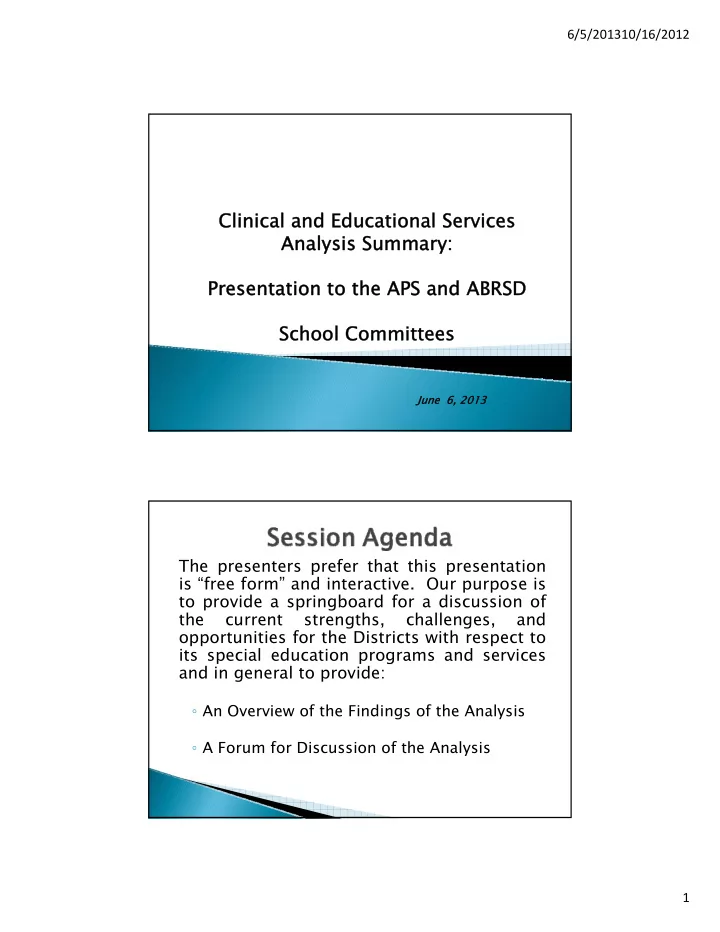

6/5/201310/16/2012 Clinical and Educational Services Clinical and Educational Services An Analysis Summary: alysis Summary: Presentation to the APS and ABRSD Presentation to the APS and ABRSD School Committees School Committees June 6, 2013 June 6 2013 The presenters prefer that this presentation is “free form” and interactive. Our purpose is to provide a springboard for a discussion of the current strengths, challenges, and opportunities for the Districts with respect to its special education programs and services and in general to provide: ◦ An Overview of the Findings of the Analysis ◦ A Forum for Discussion of the Analysis 1
6/5/201310/16/2012 Michael N chael Neiman, Ph.D. iman, Ph.D. Michael Pa chael Palladino lladino. Ph.D. Ph.D. Richard Judah, De.D. Richard Judah, De.D. Richa Richard La d LaBrie, M.A. Brie, M.A. The rationale of the CESA: As Futures’ personnel began providing services within school districts, it became evident as contractors that we were not necessarily contributing to improvements at a more global level in the effective and efficient delivery of services to students. Both we, and the districts that we served, began asking the fundamental question: Can we improve the delivery of services within existing fiscal and personnel resources? The ultimate purpose of our consultative projects (which include 260 schools districts across the country, including 65 in Massachusetts, are to support our partners as fellow practitioners in a collaborative process in order to provide services that are more effective and efficient. 2
6/5/201310/16/2012 Interviews Interviews All interviews were confidential, allowing for candid responses Interview questions were tailored according to the interviewees ’ particular areas of expertise and relevance to the area (s) under review A representative number of related service providers, educators, para ‐ educators, administrators , and parents involved in the areas under review were interviewed in order to attain valuable and contributory qualitative information from a variety of perspectives. In all there were 106 interviews Document Reviews Document Reviews Si Site Visi te Visits to th ts to the e Districts’ Districts’ programs programs Quan Quantita titative An tive Analyses alyses “Cultural” Aspects 1.Ownership of All Students 2.Parental and Community Expectations of the CSE and the CSE Team District Resource Capacity Systematic/Procedural/Cultural 1. General Education Interventions 2. Absence of Entrance and Exit Criteria 3
6/5/201310/16/2012 (Encompassing related services, the psychology and counselor models, and para-professional supports) Primary Findings The related service providers (RSPs) understand, and support, students using the educational model of service delivery. There is an opportunity to make decisions regarding eligibility for, and exit from, services more uniform and consistent across the schools comprising APS and ABRSD. When using a benchmarking standard, the number of speech-language pathologists and occupational therapists is considered to be a generous model that can be seen as an investment in keeping students within the Districts; the number of physical therapists is less than is expected. Primary Findings (continued) The authors were extremely impressed by how the counselors and psychologists are being utilized in the Districts. When considered as a whole, their numbers are not as high as would be expected across both Districts The numbers of para-professionals in APS are relatively high, but must be viewed by specific mitigating variables: (1) the District’s commitment to inclusion; (2) the relatively fewer number of special education teachers in APS in comparison to similar districts; (3) the low number of students currently in out of district placements; and (4) there are less para- professionals at the secondary level suggesting student independence is enhanced by this “front-loading” of para-professional supports . 4
6/5/201310/16/2012 Primary Findings (continued) FTE Expected Ratio District Para-Professionals Actual Ratio Acton Public Schools 70.9 5.4:1 8.5:1 Acton-Boxboro Regional 34.7 11:1 8.5:1 School District Average 52.8 8.2:1 8.5:1 Recommendations The related services providers should convene to further operationalize entrance and exit criteria based on a workload model, defining roles and responsibilities, and reinforcing classroom interventions. In this manner, it may be possible as part of long-term planning to re-deploy greater S-LP resources at the elementary level. The psychologists should convene to revisit how they identify students with (or without) specific learning disabilities. In addition, there may a greater opportunity for all Student Assistance Team members, of which they are a part, to support students with Academic Support Centers. Continue to reflect of how to maximize return on investment on the para- professional model with defining roles, professional development, and finding the right balance of certified and non-certified staff. 5
6/5/201310/16/2012 (Encompassing transportation and Medicaid) Findings The CASE Collaborative provides effective and efficient routing and scheduling for the Districts. The Districts have been well-served and could not do better than this current model by either self-operating or using contracted vendors. Currently, the Districts do not access the Fee for Service component of the Municipal Medicaid Program, which is one of the few sources of revenue available to districts to help defray the costs of some services within the purview of special education. It is estimated that this annual revenue would approach $200,000 across the Districts. Recommendations It may be possible for the District to eliminate 1 bus in Tier 1 and redistribute the student load and reconfigure the routes in Tier 1 to absorb those added students. In order to capture appropriate Medicaid revenues, the Districts may choose to contract with a vendor with expertise in this area to facilitate all of the necessary requirements. 6
6/5/201310/16/2012 As indicated in our full report APS and ABRSD are those rare districts that provide services to students that are both effective and efficient. We would like to end the formal presentation with an excerpt from the full report: The Districts’ special education programs are extremely well-led by Ms. Huber. En toto, the department provides exemplary educational services and programs to its students that are in keeping with the letter and spirit of the policies and procedures contained within IDEA and the state of Massachusetts. The programs offered to students with disabilities are both programmatically sound and are fiscally responsible . 7
Recommend
More recommend